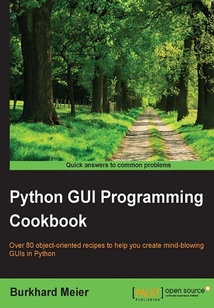目錄(123章)
倒序
- 封面
- 版權(quán)頁
- Credits
- About the Author
- About the Reviewers
- www.PacktPub.com
- Support files eBooks discount offers and more
- Preface
- What this book covers
- What you need for this book
- Who this book is for
- Conventions
- Reader feedback
- Customer support
- Chapter 1. Creating the GUI Form and Adding Widgets
- Introduction
- Creating our first Python GUI
- Preventing the GUI from being resized
- Adding a label to the GUI form
- Creating buttons and changing their text property
- Text box widgets
- Setting the focus to a widget and disabling widgets
- Combo box widgets
- Creating a check button with different initial states
- Using radio button widgets
- Using scrolled text widgets
- Adding several widgets in a loop
- Chapter 2. Layout Management
- Introduction
- Arranging several labels within a label frame widget
- Using padding to add space around widgets
- How widgets dynamically expand the GUI
- Aligning the GUI widgets by embedding frames within frames
- Creating menu bars
- Creating tabbed widgets
- Using the grid layout manager
- Chapter 3. Look and Feel Customization
- Introduction
- Creating message boxes – information warning and error
- How to create independent message boxes
- How to create the title of a tkinter window form
- Changing the icon of the main root window
- Using a spin box control
- Relief sunken and raised appearance of widgets
- Creating tooltips using Python
- How to use the canvas widget
- Chapter 4. Data and Classes
- Introduction
- How to use StringVar()
- How to get data from a widget
- Using module-level global variables
- How coding in classes can improve the GUI
- Writing callback functions
- Creating reusable GUI components
- Chapter 5. Matplotlib Charts
- Introduction
- Creating beautiful charts using Matplotlib
- Matplotlib – downloading modules using pip
- Matplotlib – downloading modules with whl extensions
- Creating our first chart
- Placing labels on charts
- How to give the chart a legend
- Scaling charts
- Adjusting the scale of charts dynamically
- Chapter 6. Threads and Networking
- Introduction
- How to create multiple threads
- Starting a thread
- Stopping a thread
- How to use queues
- Passing queues among different modules
- Using dialog widgets to copy files to your network
- Using TCP/IP to communicate via networks
- Using URLOpen to read data from websites
- Chapter 7. Storing Data in Our MySQL Database via Our GUI
- Introduction
- Connecting to a MySQL database from Python
- Configuring the MySQL connection
- Designing the Python GUI database
- Using the SQL INSERT command
- Using the SQL UPDATE command
- Using the SQL DELETE command
- Storing and retrieving data from our MySQL database
- Chapter 8. Internationalization and Testing
- Introduction
- Displaying widget text in different languages
- Changing the entire GUI language all at once
- Localizing the GUI
- Preparing the GUI for internationalization
- How to design a GUI in an agile fashion
- Do we need to test the GUI code?
- Setting debug watches
- Configuring different debug output levels
- Creating self-testing code using Python's __main__ section
- Creating robust GUIs using unit tests
- How to write unit tests using the Eclipse PyDev IDE
- Chapter 9. Extending Our GUI with the wxPython Library
- Introduction
- How to install the wxPython library
- How to create our GUI in wxPython
- Quickly adding controls using wxPython
- Trying to embed a main wxPython app in a main tkinter app
- Trying to embed our tkinter GUI code into wxPython
- How to use Python to control two different GUI frameworks
- How to communicate between the two connected GUIs
- Chapter 10. Creating Amazing 3D GUIs with PyOpenGL and PyGLet
- Introduction
- PyOpenGL transforms our GUI
- Our GUI in 3D!
- Using bitmaps to make our GUI pretty
- PyGLet transforms our GUI more easily than PyOpenGL
- Our GUI in amazing colors
- Creating a slideshow using tkinter
- Chapter 11. Best Practices
- Introduction
- Avoiding spaghetti code
- Using __init__ to connect modules
- Mixing fall-down and OOP coding
- Using a code naming convention
- When not to use OOP
- How to use design patterns successfully
- Avoiding complexity
- Index 更新時間:2021-07-30 10:08:51
推薦閱讀
- 24小時學(xué)會電腦組裝與維護(hù)
- 圖解西門子S7-200系列PLC入門
- 新型電腦主板關(guān)鍵電路維修圖冊
- 電腦維護(hù)與故障排除傻瓜書(Windows 10適用)
- Unity 5.x Game Development Blueprints
- 從零開始學(xué)51單片機(jī)C語言
- 微服務(wù)分布式架構(gòu)基礎(chǔ)與實(shí)戰(zhàn):基于Spring Boot + Spring Cloud
- Intel Edison智能硬件開發(fā)指南:基于Yocto Project
- FL Studio Cookbook
- 電腦橫機(jī)使用與維修
- The Artificial Intelligence Infrastructure Workshop
- 單片機(jī)項目設(shè)計教程
- Arduino項目案例:游戲開發(fā)
- 筆記本電腦現(xiàn)場維修實(shí)錄
- USB 3.0編程寶典
- CPU設(shè)計實(shí)戰(zhàn):LoongArch版
- 電腦組裝與硬件維修從入門到精通
- Unreal Engine 4 AI Programming Essentials
- Hands-On Embedded Programming with C++17
- FPGA的人工智能之路:基于Intel FPGA開發(fā)的入門到實(shí)踐
- 3D打印:從全面了解到親手制作(全彩版)
- Avid Media Composer 6.x Cookbook
- Building Smart LEGO MINDSTORMS EV3 Robots
- 圖解芯片技術(shù)
- 持久內(nèi)存架構(gòu)與工程實(shí)踐
- Building Bluetooth Low Energy Systems
- CPU自制入門
- Blender 3D Printing Essentials
- Premiere視頻制作入門與實(shí)戰(zhàn)
- Salesforce CRM:The Definitive Admin Handbook(Second Edition)


